Underwater photography / In-water photography camera protection tips
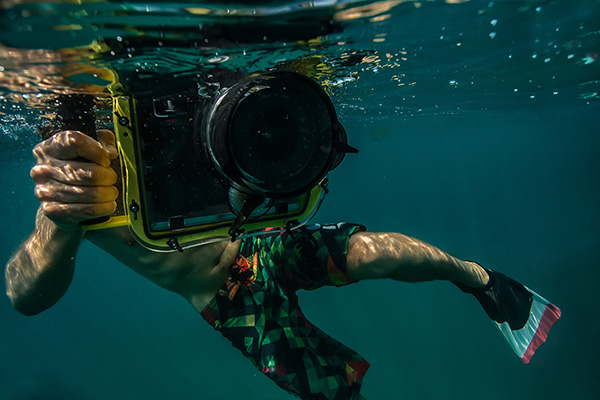
Source: Royalty-free stock photo ID: 386799562, Shutterstock
Let’s face it – photographing underwater is an inherently precarious situation, but it can also result in some amazing imagery, so the reward can sometimes outweigh the risk. And photographers will continue doing underwater photography as long as this prospect exists, so let’s review some ways that photographers can protect their valuable gear while underwater.
Note: underwater photography is not automatically covered and requires special underwriting authorization (but coverage is available). Contact us for more information.
Tips on protecting your camera underwater / underwater photography
Consider using a dome cover for your camera such as the Vbestlife Underwater Diving Dome [Amazon Link]; these waterproof domes lengthen the distance between the lens and water by ~30mm, with a wide angle to make the picture clearer.
Get a water resistant hard case for your memory cards, such as the Honsky Water Resistant Memory Card Carrying Case [Amazon Link]. A water resistant phone case would also be an option for holding the memory cards, such as the JOTO Universal Waterproof Pouch [Amazon Link].
Get a waterproof camera strap to attach to your underwater camera and/or housing so that your camera doesn’t float away from you! One example of such a product is a Waterproof Camera Floating Hand Strap [Amazon Link].
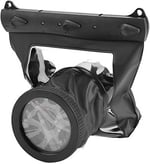 There are underwater camera bags; most are for DSLR cameras. The DSLR Camera Universal Waterproof Underwater Pouch [Amazon Link] looks like a decent option. It is waterproof down to 20 meters deep.
There are underwater camera bags; most are for DSLR cameras. The DSLR Camera Universal Waterproof Underwater Pouch [Amazon Link] looks like a decent option. It is waterproof down to 20 meters deep.
Get a dry bag that fits all your gear or even a whole backpack. Something like the NKLC Waterproof Bag [Amazon Link] should work. It is large enough to carry most photography equipment and is 100% waterproof.
Try to minimize contact with the reef when shooting. Many underwater photographers carry a simple aluminum rod [Amazon Link] that also doubles as a pointing device for this purpose.
Underwater camera housings – how to know they are adequate?
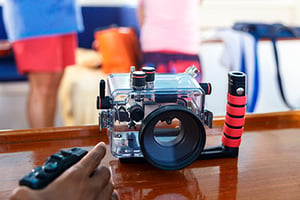 It’s true – there’s something scary about trusting a piece of plastic to protect $1,000 (or much more) worth of equipment from near certain death by drowning. This technique is not recommended for amateur photographers as it is a delicate operation, but most professional photographers shooting underwater will use DSLRs in underwater housings.
It’s true – there’s something scary about trusting a piece of plastic to protect $1,000 (or much more) worth of equipment from near certain death by drowning. This technique is not recommended for amateur photographers as it is a delicate operation, but most professional photographers shooting underwater will use DSLRs in underwater housings.
Don’t trust a simple plastic bag to protect your camera underwater, especially if it’s an expensive DSLR. However, keep in mind that high quality DSLR housings can sometimes cost more than the camera!
To be as safe as possible, first, you’ll want to purchase a housing that was specifically designed for your camera, if available. The Sony a6000, for example, has the N\C 40m Underwater Waterproof Camera Housing [Amazon Link]. The Olympus TG6 has the Olympus PT-059 Underwater Housing [Amazon Link], and so on…
Testing underwater camera housings / underwater camera housing test
You should always test your housing before every use. Always be sure to read and adhere to the special manufacturer directions before using your housing (prior to submerging the camera/housing, be sure of limits on depth of operations).
You can also get a vacuum device such as the Backscatter AirLock Vacuum System with Manual Valve to verify that your housing is free of leaks before you take it into water.
Once ready to shoot underwater – before entering – consider doing a slow entrance into the water and, ideally, have someone in the boat lower your camera down to you.
Note: approximately every 10m/30ft adds one atmosphere of pressure to your casing, so keep that in mind if you do discover minor leaks.
Best cameras for in-water photography / best underwater cameras
Always favour weather sealed cameras. Weather sealing a camera refers to having rubber gaskets in the seams to keep water from the camera’s internals. However, if the lens doesn't have weather sealing also, water can still enter into the camera through the lens mount. Therefore, make sure to keep the lens mount dry.
Many cameras are already weather sealed, but don’t assume that your camera is necessarily weather sealed just because it’s a new model. Be sure to check with the camera manufacturer to verify.
GoPro is likely the first brand that most people think of when thinking underwater photography, and certainly they have some good options, such as the GoPro HERO7 Waterproof Action Camera, which also has a Waterproof Housing from FitStill. [Amazon Links] However, the image quality on GoPros often isn’t the greatest and they’re generally better for videography than photography.
Inexpensive point-and-shoot cameras for which you can find a water case/bag should be considered, especially if you don’t want to risk flooding an expensive DSLR.
Some underwater cameras to consider:
- The Sealife Micro 3.0 [Amazon Link] is waterproof down to 200 ft. (60 m)!
- The Nikon COOLPIX AW130 [Amazon Link] is a durable camera that is waterproof down to 100 ft., freezeproof and shockproof
- The Canon PowerShot D30 [Amazon Link] is waterproof down to 82 ft. below sea level
- The Olympus TG-6 [Amazon Link] is waterproof (50 ft. / 15 m), dustproof, shockproof, crushproof, and freezeproof
- The Ricoh WG-50 [Amazon Link] is waterproof down to 46 ft. – perfect for use when submerged
- The Panasonic DMCTS30A [Amazon Link] is waterproof down to 26 ft. (8 m)
Some In-Water Photographs | Underwater Photography | Underwater Photographer
In-water photography tip: Get a strobe light! An underwater strobe [Amazon Link], AKA underwater flash, is important in underwater photography because it allows you to reduce backscatter (diffuse reflection) and enables you to capture better imagery in dark waters.
Maybe one of these nice in-water pictures can help inspire you to do some underwater photography of your own:
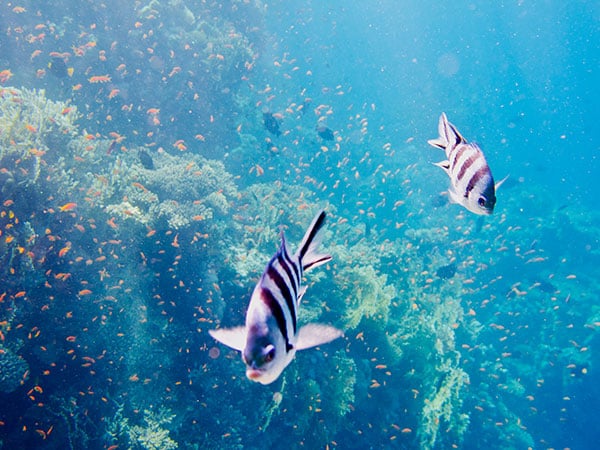
Shallow coral reef and red tropical fish. Yellow corals and swimming fish. Underwater photography from snorkeling with the marine life. Location: South Sinai Governorate, Egypt. Shutterstock: Royalty-free stock photo ID: 1716574591
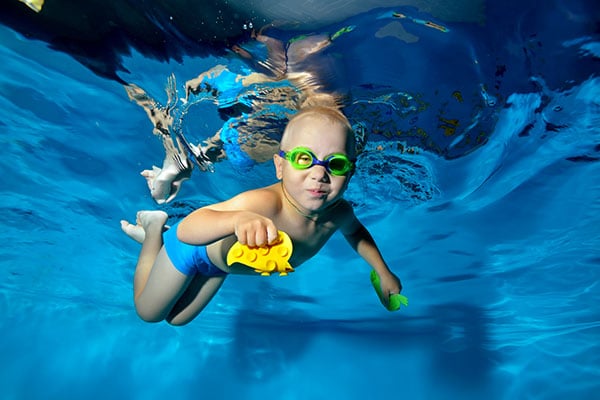
Happy child engaged in sports swimming in the pool. He swims underwater on a blue background in swimming goggles and with toys in his hands. Shutterstock: Royalty-free stock photo ID: 1151510360
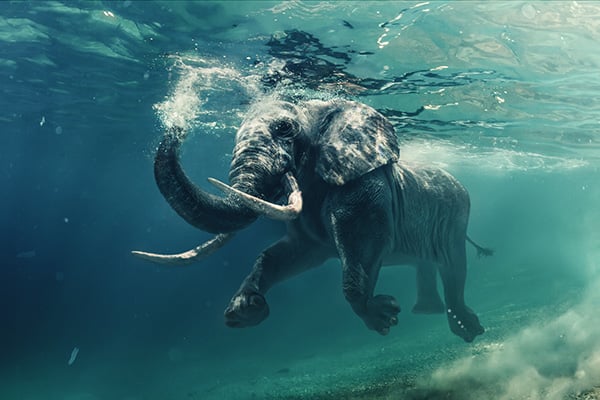
Swimming Elephant Underwater. African elephant in ocean with mirrors and ripples at water surface. Shutterstock: Royalty-free stock photo ID: 360848669
Get Photography Equipment Insurance | Front Row Photography | Photographer Insurance | Underwater Photography Insurance
Hopefully these tips should allow you to avoid water-related damage to your photography gear. However, just in case something like that does happen, you will want to have photography insurance in place to help cover the cost of repair/replacement.
Front Row’s insurance for photographers is a good option for insuring your photo gear. You can get a quote online and purchase a policy in five minutes, or read more about the coverages available on the photography insurance site.
Note: underwater photography is not automatically covered and requires special underwriting authorization (but coverage is available). Contact us for more information.
Refer a Friend to Front Row Insurance
Based on customer demand, we’ve setup our referral marketing program and if you refer a friend to Front Row, you could win a $15 Amazon eGift Card OR be entered into a random draw to win a $99 Amazon eGift Card! (depending on your province)
Related Posts:
FREE EBOOK! PHOTOGRAPHY INSURANCE 101: PROTECT YOUR CAMERA GEAR
PHOTOGRAPHY EQUIPMENT INSURANCE: YOU MAY NOT BE COVERED BY HOMEOWNERS
I’M JUST STARTING OUT IN MY PHOTOGRAPHY BUSINESS; DO I NEED INSURANCE?
4 QUESTIONS TO CONSIDER WHEN BUYING PHOTOGRAPHY BUSINESS INSURANCE
THEFT FROM VEHICLE: PHOTOGRAPHY INSURANCE EXPLAINED
PHOTOGRAPHERS & VIDEOGRAPHERS: SAVE MONEY ON YOUR CAMERA INSURANCE
HOW TO REDUCE THE COST TO INSURE YOUR PHOTOGRAPHY EQUIPMENT
HOW TO PROTECT YOUR CAMERA LENS(ES)
WHAT TO KNOW ABOUT RAIN PHOTOGRAPHY: PROTECTING YOUR CAMERA IN RAIN
UNDERWATER PHOTOGRAPHY BEST PRACTICES / IN-WATER PHOTOGRAPHY
PROTECT YOUR CAMERA GEAR FROM OVERHEATING
PROTECT YOUR CAMERA AT THE BEACH / PROTECT YOUR CAMERA FROM SAND
ORGANIZING YOUR CAMERA GEAR / KEEP TRACK OF YOUR PHOTOGRAPHY GEAR
INSURANCE FOR PHOTOS BOOTHS | PHOTO BOOTH INSURANCE FROM FRONT ROW
HOW DO I ADD AN ADDITIONAL INSURED TO MY POLICY?
5 THINGS TO KNOW ABOUT MAKING A PHOTOGRAPHY INSURANCE CLAIM
FRONT ROW: OFFERING ONLINE CAMERA INSURANCE POLICIES FOR PHOTOGRAPHERS
DISCLAIMER: Informational statements regarding insurance coverage are for general description purposes only. These statements do not amend, modify or supplement any insurance policy. Consult the actual policy or your broker for details regarding terms, conditions, coverage, exclusions, products, services and programs which may be available to you. Your eligibility for particular products and services is subject to the final determination of underwriting qualifications and acceptance by the insurance underwriting company providing such products or services. This website does not make any representations that coverage does or does not exist for any particular claim or loss, or type of claim or loss, under any policy. Whether coverage exists or does not exist for any particular claim or loss under any policy depends on the facts and circumstances involved in the claim or loss and all applicable policy wording.
Amazon Associates Disclosure: Front Row Insurance is a participant in the Amazon Services LLC Associates Program, an affiliate advertising program designed to provide a means for sites to earn advertising fees by advertising and linking to Amazon. This post may contain affiliate links. There is no additional cost to you.
Citations:
https://photographycourse.net/testing-underwater-housing-before-entering-the-water/

Submit a comment